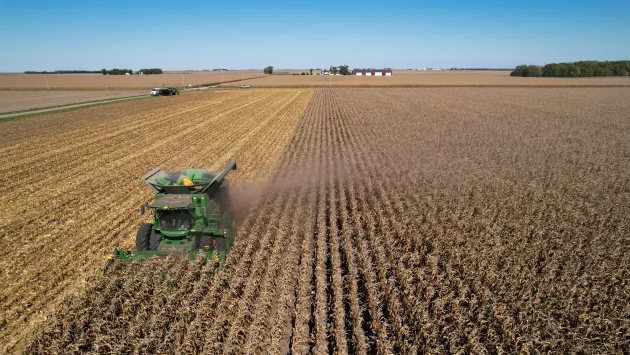May 28, 2025 | 03:41 GMT +7
May 28, 2025 | 03:41 GMT +7
Hotline: 0913.378.918
May 28, 2025 | 03:41 GMT +7
Hotline: 0913.378.918

A combine harvests corn, Tuesday, Oct. 10, 2023, at a farm near Allerton, Ill. Photo: Joshua A. Bickel.
That’s more than four times the amount of money spent by the public sector and civil society, according to public data compiled by the Union for Concerned Scientists (UCS). The group found that nonprofits, labor unions, state and local governments and tribal nations spent a total of $95 million over the same period.
“The food and farm bill has the power to transform our food and farm system, and agribusiness and industry groups know this,” report co-author Karen Perry Stillerman said.
These groups “started lobbying from almost the moment the last farm bill was enacted, showing that these groups are always working to influence this legislation in their favor.”
The last farm bill was enacted in 2018 and was set to expire in 2023, before it was extended by one year. Congress’s budget for the total package is estimated at approximately $1.5 trillion, to be spent over 4 years.
Spending sped up last year as the farm bill’s expiration after five years neared, the report said.
Earlier this month, America got a picture of dueling Republican and Democratic priorities for the farm bill. Both proposals included language to increase crop insurance for the biggest agricultural operations growing commodities like corn, soy, wheat, dairy, lumber and sugar.
Both parties’ proposals also include heightened support for American food exports.
Both Democrats and Republicans want to increase funding to crop insurance programs, though Republicans have gone further in this regard.
“A pay-to-play food policy that prioritizes corporate profits is bad for the well-being of people and the environment,” UCS authors concluded.
“Lawmakers should center the needs of small and midsize farms, diverse farmers, food workers and farmworkers, consumers, and communities — not just the needs of giant corporations — when writing this legislation.”
(The Hill)

(VAN) Available cropland now at less than five percent, according to latest geospatial assessment from FAO and UNOSAT.

(VAN) Alt Carbon has raised $12 million in a seed round as it plans to scale its carbon dioxide removal work in the South Asian nation.

(VAN) Attempts to bring down the price of the Japanese staple have had little effect amid a cost-of-living crisis.

(VAN) Fourth most important food crop in peril as Latin America and Caribbean suffer from slow-onset climate disaster.

(VAN) Shifting market dynamics and the noise around new legislation has propelled Trouw Nutrition’s research around early life nutrition in poultry. Today, it continues to be a key area of research.

(VAN) India is concerned about its food security and the livelihoods of its farmers if more US food imports are allowed.

(VAN) FAO's Director-General emphasises the need to work together to transform agrifood systems.